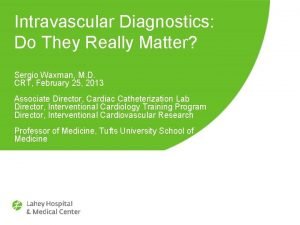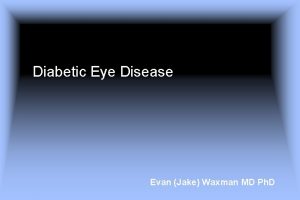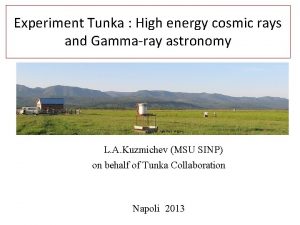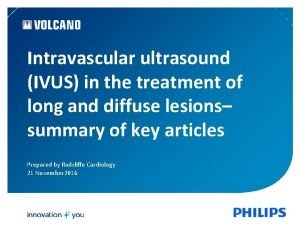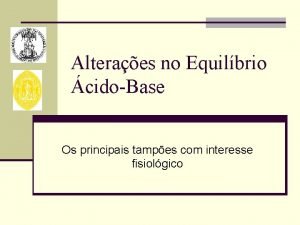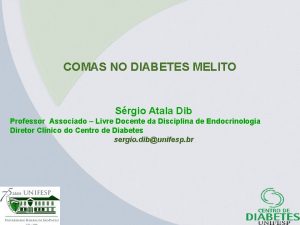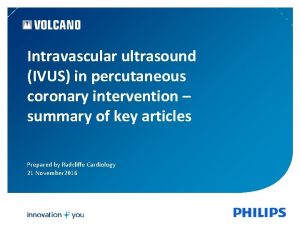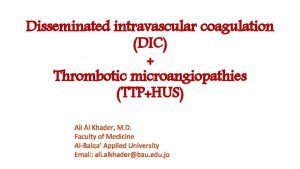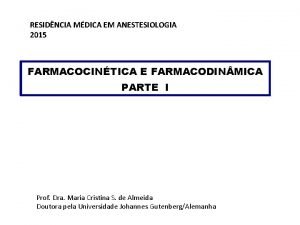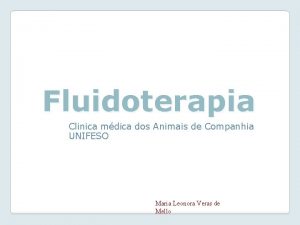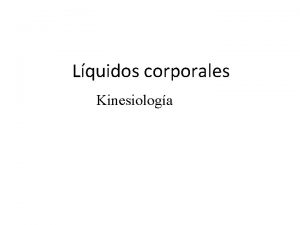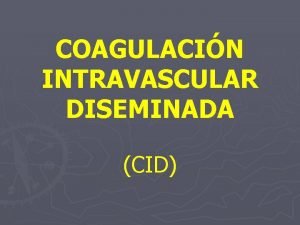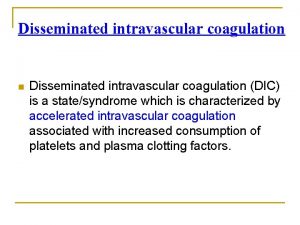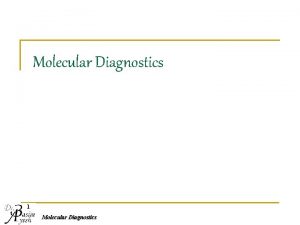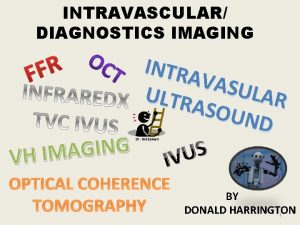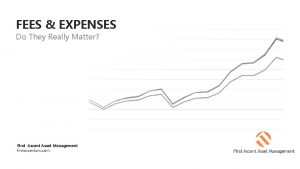Intravascular Diagnostics Do They Really Matter Sergio Waxman



























- Slides: 27

Intravascular Diagnostics: Do They Really Matter? Sergio Waxman, M. D. CRT, February 25, 2013 Associate Director, Cardiac Catheterization Lab Director, Interventional Cardiology Training Program Director, Interventional Cardiovascular Research Professor of Medicine, Tufts University School of Medicine

Sergio Waxman, MD Consulting: Infra. Re. Dx, Inc. Stocks, Stock Options, other ownership interest: Angio. Light

Why IVDx Technologies? Known limitations of angiography to define CAD Diagnostic advantages for adjunct use of IVDx technologies… • Provide physiologic information (e. g. , Fractional Flow Reserve [FFR]) • Provide structural information such as lumen narrowing, plaque burden, lesion borders, remodeling (e. g. , Intravascular ultrasound [IVUS], OCT) • Provide information re. plaque composition such as calcification, LCP, inflammation (e. g. VH-IVUS, OCT, NIRS) Potential benefits of adjunct use of IVDx technologies… • Optimize treatment based on additional information • Improve patient outcomes

Current Paradigm for Diagnosing and Treating CAD Treatment is the same regardless of plaque morphology or extent of disease and is currently guided by angio”steno”graphy TCFA Stent/DAPT/statin Stable lesion Diffuse vs focal disease Ruptured plaque Area of most severe angiographic stenosis 5

A New Diagnostic and Therapeutic Paradigm? Plaque Dx: - Physiology - Structure - Composition = Lesion Tailored Therapy Optimize PCI Result Improve Patient Outcomes Costs/ Quality Yet IVDx are used in <10% of PCI cases We need to look for evidence that justifies higher use of IVDx

Potential Applications of IVDx Key areas for IVDX studies: • Plaque morphology (VP) [IVUS, OCT, NIRS] • Diagnostic lesion assessment (to treat or not to treat) [FFR, IVUS, OCT, NIRS] • Pre-intervention imaging (planning )[IVUS, OCT, NIRS] • Post-intervention optimization (fine tuning) [FFR, IVUS, OCT] • Complication evaluation [IVUS, OCT] • Restenosis evaluation [IVUS, OCT] • Stent thrombosis evaluation [IVUS, OCT] • Stent coverage [IVUS, OCT]

Adoption of IVDX: Finding the Right Application Cost/Benefit = Threshold of acceptance/rej ection Units of benefit/ cost Benefit Cost Benefi Cost t Benefit: Improved Clinical Outcome + Cost Savings Cost: Risk to patient + Ease of use + Ease of interpretation + $$

Adoption of IVDX: Finding the Right Application Threshold of acceptance/rej ection Units of benefit/ cost Benefit Cost Benefi Cost t Benefit: Improved Clinical Outcome + Cost Savings Cost: Risk to patient + Ease of use + Ease of interpretation + $$

Analytical Framework for Assessing Utility of IVDX in Clinical Practice Patients with ACS undergoing PCI *Therapeutic decision-making outcomes include: 1) Change in the decision if stenting is needed; 2) Change in the number or the type of stents; 3) Change in the decision for reintervention Modified from: Raman G, Ip S, et al. IVDx Procedures and Imaging Techniques vs Angiography Alone: A Comparative Effectiveness Review. Draft Document, AHRQ/HHS May 2012

Rating the Strength of Evidence of Available Studies for Each Key Question Strength of evidence based on 4 domains: - Risk of bias - Consistency - Directness - Precision High ●●● Further research is very unlikely to change the confidence in the estimate of effect. Moderate ●●○ Further research may change the confidence in the estimate of effect and may change the estimate. Low ●○○ Further research is likely to change the confidence in the estimate of effect and is likely to change the estimate. Insufficient ○○○ Evidence either is unavailable or does not permit estimation of an effect. Raman G, Ip S, et al. IVDx Procedures and Imaging Techniques vs Angiography Alone: A Comparative Effectiveness Review. Draft Document, AHRQ/HHS May 2012

Key Question 1 What is the impact of using IVDx and angiography in deciding whether a coronary lesion requires intervention – when compared to angiography alone • Strength of evidence is moderate that supports the use of FFR + angiography vs. angiography alone (1 RCT and 2 non-randomized studies) • Aids in deciding whether and which lesions to stent • Lower risk of death or myocardial infarction (MI) or Major Adverse Cardiac Events (MACE) • Lower resource utilization in the short-term • Strength of evidence is insufficient for assessing: • Quantitative coronary angiogram and stent-related outcomes • Short-term patient-centered outcomes • Techniques other than FFR Raman G, Ip S, et al. IVDx Procedures and Imaging Techniques vs Angiography Alone: A Comparative Effectiveness Review. Draft Document, AHRQ/HHS May 2012

Key Question 2 For patients undergoing PCI, what is the impact of using IVDx and angiography to guide stent placement (either immediately prior to or during the procedure)—when compared to angiography alone • Strength of evidence is moderate that supports the use of IVUS + angiography vs. angiography alone (9 RCTs and 17 non-randomized studies) • Decreases target vessel revascularization • Decreases stent restenosis • Aids in optimizing stent placement • Increases short-term resource utilization • No significant difference in mortality, MI and MACE • No significant difference in quantitative coronary angiogram • Strength of evidence is insufficient that supports the use of FFR (1 high-risk of bias non-randomized study) • Strength of evidence is insufficient for all other techniques (no studies) Raman G, Ip S, et al. IVDx Procedures and Imaging Techniques vs Angiography Alone: A Comparative Effectiveness Review. Draft Document, AHRQ/HHS May 2012

Meta-analyses of Observational and Randomized IVUS Studies During PCI TV Revascularization –medium term Myocardial Infarction –medium term Mortality –medium term

Can Use of IVUS During PCI Improve Outcomes? ADAPT-DES IVUS Sub-Study IVUS Use and Definite/Probable ST at 1 Yr IVUS Use and Spontaneous MI (not ST) at 1 Yr Witzenbichler B, Maehara A, Weisz G, et al. ADAPT-DES Study, TCT 2012 15

How Did IVUS Change the Procedure? ADAPT-DES IVUS Sub-Study Witzenbichler B, Maehara A, Weisz G, et al. ADAPT-DES Study, TCT 2012 16

Can Use of OCT During PCI Improve Outcomes? CLI-OPCI Study: Angio vs Angio+OCT Findings in OCT-Guided Group • • • Clinical Results: Angio vs Angio+OCT Groups Non-randomized, consecutive pts, 1: 1 matching with randomly selected pts OCT Group: Longer stents, more overlapping stents, larger balloons, more DES OCT use not associated with any major complication Prati F, et al. CLI-OPCI, Euro. Int 2012

Key Question 3 For patients having just undergone a PCI, what is the impact of using IVDx and angiography to evaluate the success of stent placement immediately after the procedure—when compared to angiography alone • Strength of evidence is insufficient that examined this comparison (2 IVUS studies with high risk of bias) • No significant difference in short- or long-term quantitative coronary angiogram results • No significant difference in the incidence of restenosis • Strength of evidence is insufficient for all other techniques Raman G, Ip S, et al. IVDx Procedures and Imaging Techniques vs Angiography Alone: A Comparative Effectiveness Review. Draft Document, AHRQ/HHS May 2012

How can we adopt IVDx in clinical practice? Findings associated with outcomes Application FFR IVUS OCT NIRS Ischemia detection <0. 80 <3 -4 mm 2 <2 mm 2 NA Deferred PCI >0. 80 NA NA NA Endpoint of stenting >0. 94 >9 mm 2 (>6 mm 2), full apposition, >80% ref. area NA NA NA Stent CSA, edge stenosis (edge lumen CSA <4 mm 2, plaque burden >70%), stent expansion <70% Edge dissection, stent malapposition, underexpansion, thrombus, residual edge stenosis (MLA <4 mm 2) LCP at margin of stent Suboptimal PCI strategy NA Dense calcium, necrotic core (VH) Dense calcium Circumferential LCP, high LCBI VP detection (non-culprit disease) NA Plaque burden >70%, MLA <4 mm 2, VH-TCFA OCT-TCFA LCP ?

Key Factors for Adoption of IVDx Clinical • Useful applications with measurable benefits (associated with specific treatments, improvement in outcomes) • Safety Technical • Ease of use (plug-and-play systems, miniaturization) • Image interpretation (automated quantitation) • Co-registration with angiogram (integration of information, roadmap) Financial • Low costs • Reimbursement

Summary and Conclusions Use of IVDx beyond angiography alone provides additional information regarding plaque physiology, morphology, and composition that can potentially impact patient outcomes. However, evidence supporting their routine use is not available. Clinical adoption of IVDx may center around practical applications (helping make the decision to treat with PCI, or to guide and optimize PCI procedures). There is moderate strength evidence that supports use of FFR to make decision to treat a lesion and of IVUS during PCI to improve mid-term outcomes. Evidence gap for all other devices and applications (although new data are emerging from non-RCT’s). Directed RCT’s need to be performed to answer the question of whether IVDx matter beyond angiography alone. The time is ripe… (technologies are mature, pay-for-quality models, evidence-based medicine).


Key Question 4 How do different IVDx techniques compare to each other in their effects on therapeutic decision making, intermediate outcomes, and patientcentered outcomes? • Strength of evidence is insufficient that examined this comparison (1 FFR vs. IVUS non-randomized study with high risk of bias) • No significant difference in MACE at 1 yr • Strength of evidence is insufficient for other techniques (no available studies) Raman G, Ip S, et al. IVDx Procedures and Imaging Techniques vs Angiography Alone: A Comparative Effectiveness Review. Draft Document, AHRQ/HHS May 2012

Key Question 1 Evidence Gaps Based on the Findings What is the impact of using IVDx and angiography in deciding whether a coronary lesion requires intervention – when compared to angiography alone • Data on FFR-guided vs. Angiography-only-guided PCI in women and in patients with left main disease and acute MI • FFR data on comparing patients with low angina score given aggressive medical therapy instead of PCI vs. PCI guided by IVDx techniques • FFR data on <30 day outcomes • Comparative studies using other IVDx techniques besides FFR with angiography to address Key Question 1 Raman G, Ip S, et al. IVDx Procedures and Imaging Techniques vs Angiography Alone: A Comparative Effectiveness Review. Draft Document, AHRQ/HHS May 2012

Key Question 2 Evidence Gaps Based on the Findings For patients undergoing PCI, what is the impact of using IVDx and angiography to guide the stent placement (either immediately prior to or during the procedure)—when compared to angiography alone • More recent data on IVUS comparative studies • Data on the use of newer types of stents deployed using IVUS • Long-term data using IVUS • Comparative data on other IVDx techniques besides IVUS Raman G, Ip S, et al. IVDx Procedures and Imaging Techniques vs Angiography Alone: A Comparative Effectiveness Review. Draft Document, AHRQ/HHS May 2012

Key Questions 3 and 4 Evidence Gaps Based on the Findings For patients having just undergone a PCI, what is the impact of using IVDx and angiography to evaluate the success of stent placement immediately after the procedure—when compared to angiography alone How do different IVDx techniques compare to each other in their effects on therapeutic decision making, intermediate outcomes, and patientcentered outcomes? • Comparative data on all IVDx techniques Raman G, Ip S, et al. IVDx Procedures and Imaging Techniques vs Angiography Alone: A Comparative Effectiveness Review. Draft Document, AHRQ/HHS May 2012

Key Question 2 (continued) For patients undergoing PCI, what is the impact of using IVDx and angiography to guide the stent placement (either immediately prior to or during the procedure)—when compared to angiography alone • Strength of evidence is insufficient that supports the use of FFR (1 high-risk of bias non-randomized study) • Favorable changes in minimal lumen diameter and % diameter stenosis • No significant difference in long-term all–cause mortality • Strength of evidence is insufficient for all other techniques (no studies) Raman G, Ip S, et al. IVDx Procedures and Imaging Techniques vs Angiography Alone: A Comparative Effectiveness Review. Draft Document, AHRQ/HHS May 2012

Impact of IVUS Imaging on Early and Late Outcomes Following PCI With DES: A Sub-Study of the MATRIX Registry Impact on procedure: Less predilatation 54% vs 70% p<0. 01 More postdilatation 42% vs 34% p<0. 01 Larger final stent diam 3. 1 mm vs 3. 0 mm p<0. 01 Claessen BE, Mehran R, Mintz G et al. JACC Intv 2011; 4: 974 -81
 Sergio waxman md
Sergio waxman md Sergio waxman
Sergio waxman Sergio waxman md
Sergio waxman md Eli waxman
Eli waxman Waxman candles
Waxman candles Evan waxman
Evan waxman Eli waxman
Eli waxman Rankings: what are they and do they matter?
Rankings: what are they and do they matter? Disseminated intravascular coagulation pathophysiology
Disseminated intravascular coagulation pathophysiology Liquido intersticial y liquido intravascular
Liquido intersticial y liquido intravascular Ivus
Ivus Liquido intravascular
Liquido intravascular Sergio atala dib
Sergio atala dib Intravascular ultrasound
Intravascular ultrasound Hus dic
Hus dic Espaço intravascular
Espaço intravascular Liquido intravascular
Liquido intravascular Hipernatremia clasificacion
Hipernatremia clasificacion Intravascular hemolytic anemia
Intravascular hemolytic anemia Doesnt really matter
Doesnt really matter What's the matter you look really tired
What's the matter you look really tired It's not paranoia if they're really out to get you
It's not paranoia if they're really out to get you Chapter 2 section 1 classifying matter answers
Chapter 2 section 1 classifying matter answers What is grey and white matter
What is grey and white matter Classification of matter section 1 composition of matter
Classification of matter section 1 composition of matter Cerebral aqueduct
Cerebral aqueduct Grey vs white matter
Grey vs white matter Ecological succession
Ecological succession

